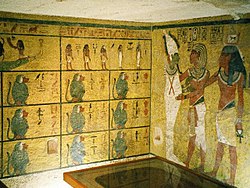Tutankhamun's tomb
| KV62 | |||
|---|---|---|---|
| Burial site of Tutankhamun | |||

The wall decorations in KV62's burial chamber
are modest in comparison with other royal tombs found in the Valley of the Kings. |
|||
| Coordinates | 25°44′24.8″N 32°36′04.8″E / 25.740222°N 32.601333°ECoordinates: 25°44′24.8″N 32°36′04.8″E / 25.740222°N 32.601333°E | ||
| Location | East Valley of the Kings | ||
| Discovered | 4 November 1922 | ||
| Excavated by | Howard Carter | ||
| Decoration | |||
|
|||
KV62 is the standard Egyptological designation for the tomb of the young pharaoh Tutankhamun in the Valley of the Kings, now renowned for the wealth of valuable antiquities it contained. The tomb was discovered in 1922 by Howard Carter, underneath the remains of workmen's huts built during the Ramesside Period; this explains why it was largely spared from desecration and from the tomb clearances at the end of the 20th Dynasty, although the tomb was robbed and resealed twice in the period after its completion.
The tomb was densely packed with items in great disarray, partly due to its small size, the two robberies, and the apparently hurried nature of its completion. Due to the state of the tomb, and to Carter's meticulous recording technique, the tomb took eight years to empty, the contents all being transported to the Egyptian Museum in Cairo.
Tutankhamun's tomb had been entered at least twice, not long after he was buried and well before Carter's discovery. The outermost doors of the shrines enclosing the king's nested coffins were unsealed, though the inner two shrines (three and four) remained intact and sealed.
In 1907, just before his discovery of the tomb of Horemheb, Theodore M. Davis's team uncovered a small site containing funerary artifacts with Tutankhamun's name and some embalming parts. Erroneously assuming that this site, numbered finally as KV54, was Tutankhamun's complete tomb, Davis concluded the dig. The details of both findings are documented in Davis's 1912 publication, The Tombs of Harmhabi and Touatânkhamanou; the book closes with the comment, "I fear that the Valley of the Kings is now exhausted." But Davis was to be proven spectacularly wrong.
The British Egyptologist Howard Carter (employed by Lord Carnarvon) hired a crew to help him excavate at the site of KV62. Carter went back to a line of huts that he had abandoned a few seasons earlier. After clearance of the huts and rock debris beneath, they found a stone step cut into the bedrock. A flight of steps was partially uncovered, leading to the top of a mud-plastered doorway stamped with indistinct oval seals, called cartouches. Carter ordered the staircase to be refilled, and sent a telegram to Carnarvon, who arrived two-and-a-half weeks later on 23 November along with his 21-year-old daughter, Lady Evelyn Herbert.
...
Wikipedia

